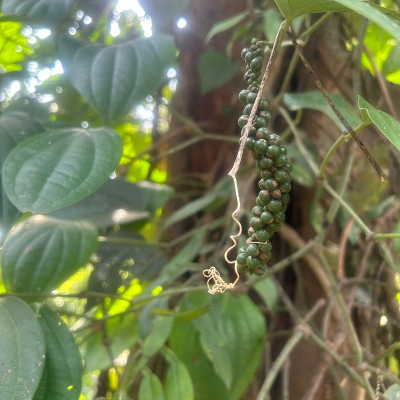Distribution and habitat: In Eastern and Western Ghats, Tamil Nadu and Kerala.
Botany: A stout glabrous climbing perennial rooting at the nodes.
- Leaves : Simple, alternate, cordate, very variable in breadth, broadly ovate, 5-9 nerved; Flowers minute in size, usually dioecious.
- Fruits : Fruiting spikes, very variable in length; Fruits ovoid or globose, one seeded berries, bright red when ripe.
- Seeds: Globose, testa thin, perisperm hard and white.
Properties: The fruits are acrid, bitter, anthelmintic, carminative, alterant, aphrodisiac, alexiteric, anti-periodic, deobsturant, diuretic, digestive, emmenagogue, antidermatic, expectorant, rubifacient, stimulant and stomachic.
Uses: Used against fever, cough, sore throat and asthma
Formulations: Thaleesapathradi churnam
Agrotechnology
Propagation: Vegetatively from cuttings. Select runner shoots produced at the base of mother plants and separate from the vines in February-March. The middle one-third portion of runner shoots is preferred for planting. The shoots are cut into pieces of 2-3 nodes in each. Leaves, if any, are to be clipped off leaving a small portion of the petiole on the top. Dipping the lower cut end of the cuttings in 1000 ppm solution of 3-Indol butyric acid for 45 seconds will substantially increase root formation and development. Treating the cuttings with Seradix B2 is equally effective. Plant the treated cuttings in nursery beds or preferably in polythene bags filled with potting mixture. The cuttings should be planted at least one node deep in the soil.
Planting: Planting is done with the onset of monsoon.
Varieties:-Panniyoor-1 to 10, Vijay, Subhakara, Sreekara, Panchami, Pournami, Malabar excel, Karimunda, Kottanadan, Kuthiravally, Arakulam Munda, Balankotta and Kalluvally are common cultivated varieties.
After cultivation: In the early stages tie the vines to the standards, if found necessary. Prune and train the standards in March-April every year to remove the excess growth. The effective height is to be limited to about 6 m.
Manuring: Apply cattle manure/ farm yard manure 10 kg/plant/year at the onset of southwest monsoon. Lining with 500 g /vine is good. Recommended nutrient dosage is NPK 50:50:50 g/vine/year for plants of 3 years and above.
Irrigation: Irrigating pepper plants of Panniyur–1 variety at IW/CPE ratio of 0.25 from November-December till the end of March and withholding irrigation thereafter till monsoon break, increases pepper yield. The depth of irrigation recommended is 10 mm. Water is to be applied in basins taken around the plants at a radius of 75 cm.
Harvesting: Pepper berries become mature and ready for harvest in about 180-200 days depending upon the variety. In high altitudes this period may be more by about 30-45 days. If spikes are harvested before attaining maturity, 15-20% reduction in the weight of processed material may result. Black pepper is produced by sun drying the mature pepper berries for 3-5 days after their separation from spikes by threshing.


